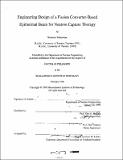| dc.contributor.advisor | Otto K. Harling. | en_US |
| dc.contributor.author | Sutharshan, Balendra, 1966- | en_US |
| dc.date.accessioned | 2009-11-06T16:17:33Z | |
| dc.date.available | 2009-11-06T16:17:33Z | |
| dc.date.copyright | 1998 | en_US |
| dc.date.issued | 1998 | en_US |
| dc.identifier.uri | http://hdl.handle.net/1721.1/49671 | |
| dc.description | Thesis (Ph.D.)--Massachusetts Institute of Technology, Dept. of Nuclear Engineering, 1998. | en_US |
| dc.description | Includes bibliographical references. | en_US |
| dc.description.abstract | There is a need for high intensity and low contamination epithermal neutron beams, for boron neutron capture therapy research and for routine treatment if this becomes a successful modality for treating cancers. A fission converter based design for high performance epithermal neutron beam was developed at the Nuclear Reactor Laboratory of the Massachusetts Institute of Technology. This epithermal beam has the capability of delivering a treatment within minutes with negligible background contamination. This thesis deals with the engineering design of this facility. This fission converter based epithermal facility will be installed in the present thermal column and hohlraum of the MITR-II. The fission converter tank, which contains eleven MITR-II fuel elements, was designed with minimum front plate thickness to minimize neutron absorption. The converter tank structural analysis was performed analytically, and numerically with the finite element code ADINA. Three heat removal designs, natural convection, forced convection with bypass channel and simple forced convection, were considered to remove heat from eleven fuel elements in the fission converter tank. For all three designs, steady state and transient analyses were performed. The transient analysis includes loss of flow, loss of flow with shutter failure (converter scram) and loss of coolant. Most of these steady state and transient analyses were performed by both analytically and numerically. The results show that the fuel disruption will not occur during credible and incredible accident scenarios. Three shutters, cadmium shutter, water shutter and mechanical fast acting shutter were designed to control the beam at the patient position. The shutters were designed using the Monte Carlo radiation transport code MCNP. A medical irradiation room was designed for patient irradiation. The shielding computations for the medical room were also carried out with the MCNP. Fuel handling was investigated and proposed two options for refueling, which are similar to the MITR-II refueling. | en_US |
| dc.description.statementofresponsibility | by Balendra Sutharshan. | en_US |
| dc.format.extent | 340 p. | en_US |
| dc.language.iso | eng | en_US |
| dc.publisher | Massachusetts Institute of Technology | en_US |
| dc.rights | M.I.T. theses are protected by
copyright. They may be viewed from this source for any purpose, but
reproduction or distribution in any format is prohibited without written
permission. See provided URL for inquiries about permission. | en_US |
| dc.rights.uri | http://dspace.mit.edu/handle/1721.1/7582 | en_US |
| dc.subject | Nuclear Engineering | en_US |
| dc.title | Engineering design of a fission converter-based epithermal beam for neutron capture therapy | en_US |
| dc.title.alternative | Engineering design of a fission converter-based epithermal neutron beam for boron neutron capture therapy | en_US |
| dc.type | Thesis | en_US |
| dc.description.degree | Ph.D. | en_US |
| dc.contributor.department | Massachusetts Institute of Technology. Department of Nuclear Science and Engineering | en_US |
| dc.identifier.oclc | 42256110 | en_US |
